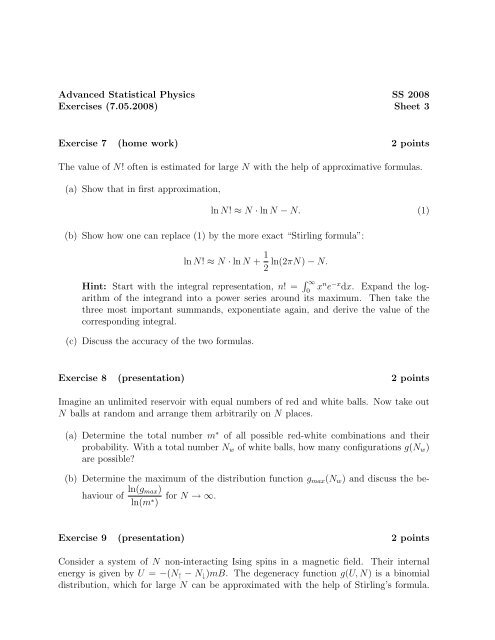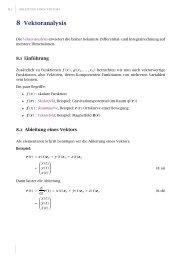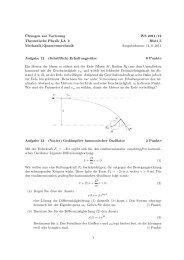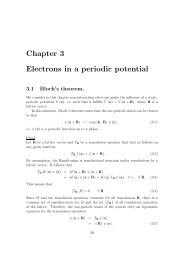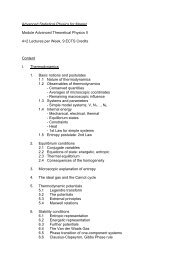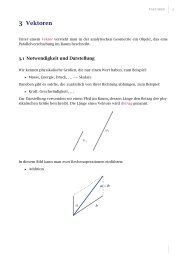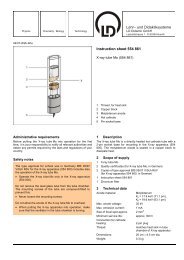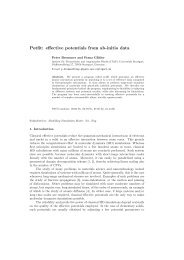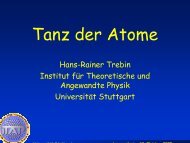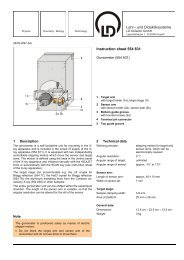Sheet 3 Exercise 7 (home work) 2 points The value of N!
Sheet 3 Exercise 7 (home work) 2 points The value of N!
Sheet 3 Exercise 7 (home work) 2 points The value of N!
- No tags were found...
Create successful ePaper yourself
Turn your PDF publications into a flip-book with our unique Google optimized e-Paper software.
Advanced Statistical Physics SS 2008<strong>Exercise</strong>s (7.05.2008) <strong>Sheet</strong> 3<strong>Exercise</strong> 7 (<strong>home</strong> <strong>work</strong>) 2 <strong>points</strong><strong>The</strong> <strong>value</strong> <strong>of</strong> N! <strong>of</strong>ten is estimated for large N with the help <strong>of</strong> approximative formulas.(a) Show that in first approximation,ln N! ≈ N · ln N − N. (1)(b) Show how one can replace (1) by the more exact “Stirling formula”:ln N! ≈ N · ln N + 1 ln(2πN) − N.2Hint: Start with the integral representation, n! = ∫ ∞x n e −x dx. Expand the logarithm<strong>of</strong> the integrand into a power series around its maximum. <strong>The</strong>n take the0three most important summands, exponentiate again, and derive the <strong>value</strong> <strong>of</strong> thecorresponding integral.(c) Discuss the accuracy <strong>of</strong> the two formulas.<strong>Exercise</strong> 8 (presentation) 2 <strong>points</strong>Imagine an unlimited reservoir with equal numbers <strong>of</strong> red and white balls. Now take outN balls at random and arrange them arbitrarily on N places.(a) Determine the total number m ∗ <strong>of</strong> all possible red-white combinations and theirprobability. With a total number N w <strong>of</strong> white balls, how many configurations g(N w )are possible?(b) Determine the maximum <strong>of</strong> the distribution function g max (N w ) and discuss the behaviour<strong>of</strong> ln(g max)for N → ∞.ln(m ∗ )<strong>Exercise</strong> 9 (presentation) 2 <strong>points</strong>Consider a system <strong>of</strong> N non-interacting Ising spins in a magnetic field. <strong>The</strong>ir internalenergy is given by U = −(N ↑ − N ↓ )mB. <strong>The</strong> degeneracy function g(U, N) is a binomialdistribution, which for large N can be approximated with the help <strong>of</strong> Stirling’s formula.
Derive the entropy function S(U, N) = k B ln g(U, N) in this approximation, and comparethe result with the postulates for the entropy.Are there postulates which are violated, and if so, for which energies? To study thesequestions, determine the temperature as a function <strong>of</strong> energy. What is the accessible energyrange, and which energies can be obtained in thermodynamic equilibrium? What is thetemperature at the minimum energy? Is our derivation using the Stirling approximationvalid at this energy? Try to compute the temperature at the energy minimum as a differencequotient between the ground state and the first excited state (without using the Stirlingapproximation), and show that it converges to zero in the thermodynamic limit (N → ∞).<strong>Exercise</strong> 10 (<strong>home</strong> <strong>work</strong>) 3 <strong>points</strong>In combinatorial exercises combinations <strong>of</strong> k elements are built out <strong>of</strong> a defined set <strong>of</strong> ndistinguishable elements (n, k ∈ N). By the following restrictions to the combinations andtheir arrangements four different kinds <strong>of</strong> exercises can be realized.I) Repetition <strong>of</strong> the same elements is possible.II) No repetition <strong>of</strong> the same elements is allowed, all elements have to be different.III) <strong>The</strong> arrangement <strong>of</strong> the elements is accounted for (“variations”).IV) Combinations that are rearrangements <strong>of</strong> each other are considered as the same(indistinguishable ordering).<strong>The</strong> number <strong>of</strong> possible combinations N c for k elements out <strong>of</strong> a set <strong>of</strong> n distinguishableelements (k, n ∈ N, k ≤ n) then is given as follows:1) Combining II + III,N c = n · (n − 1) · · · · · (n − k + 1).2) Combining II + IV,N c =n · (n − 1) · · · · · (n − k + 1)k!=( nk).3) Combining I + III,N c = n k ,4) Combining I + IV,( ) n + k − 1N c =.k
Prove the validity <strong>of</strong> these statements, e.g. by induction with respect to k. For 4),the following relation might be useful:∑n−1( ) j + k=kj=0( ) n + kk + 1(2)


